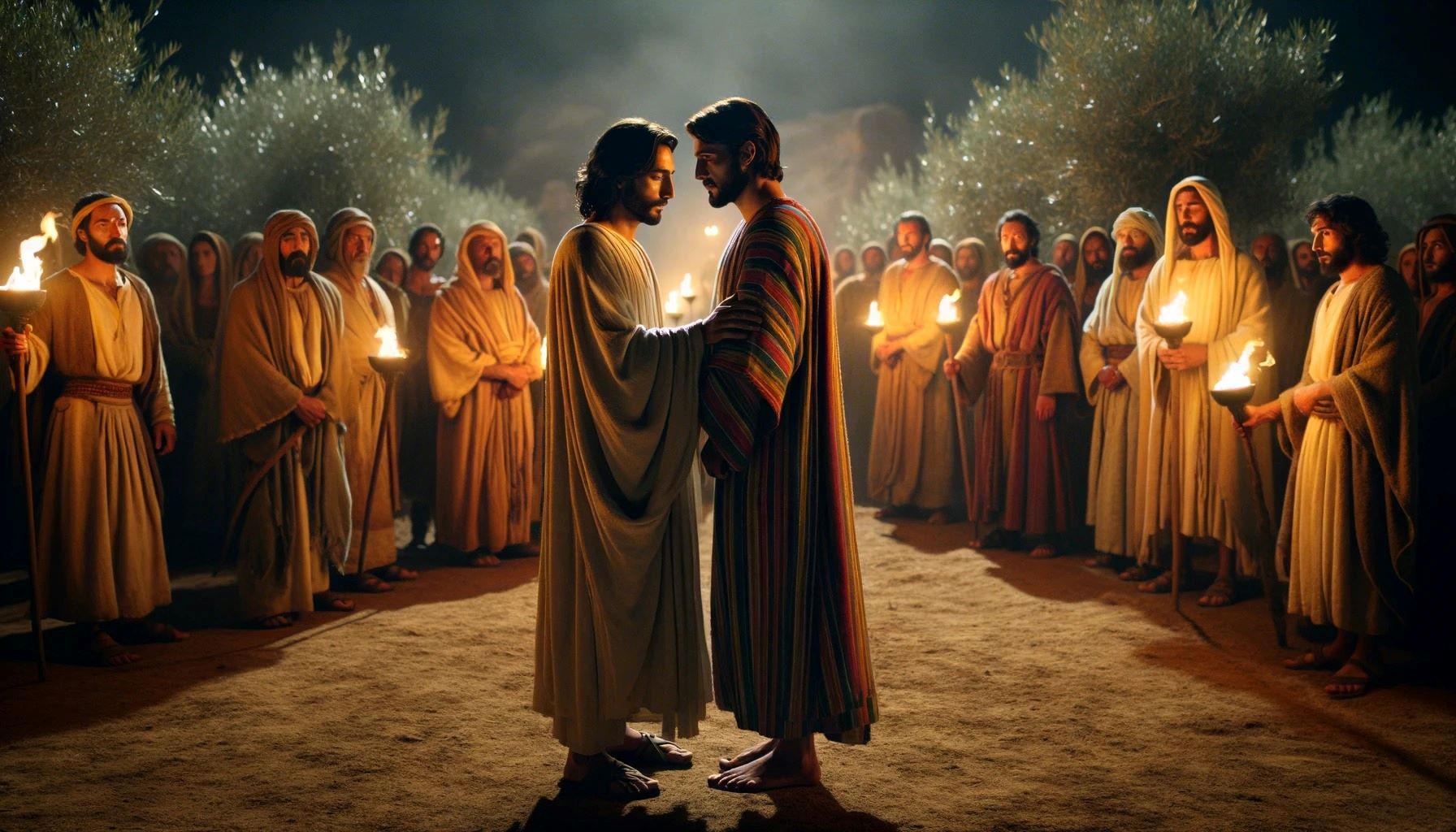Home>Christian Videos>Bible Stories>Who Are The Jews In The Gospels Of Christ?


Bible Stories
Who Are The Jews In The Gospels Of Christ?
Published: March 7, 2024
Peter Smith, Editorial Director at Christian.net, combines deep insights into faith, politics, and culture to lead content creation that resonates widely. Awarded for his contributions to religious discourse, he previously headed a major organization for religious communicators, enhancing dialogue on faith's societal impacts.
Discover the portrayal of Jews in the Gospels of Christ and their significance in Bible stories. Explore the historical and cultural context of their representation.
(Many of the links in this article redirect to a specific reviewed product. Your purchase of these products through affiliate links helps to generate commission for Christian.net, at no extra cost. Learn more)
Table of Contents
Introduction
Who are the Jews in the Gospels of Christ? This question delves into the historical and religious context of the Jewish community during the time of Jesus Christ. Understanding the role and significance of the Jews in the Gospels is crucial for comprehending the religious, social, and cultural dynamics that shaped the narratives of the New Testament. In this article, we will explore the identity of the Jews in the Gospels, their religious practices and beliefs, their interactions with Jesus, and address misconceptions and stereotypes that have emerged over time. By delving into these aspects, we can gain a deeper understanding of the pivotal role of the Jewish community in the Gospels of Christ.
Read more: Who Is Jesus In The Gospels
The Jewish Community in the Time of Christ
During the time of Christ, the Jewish community was deeply rooted in religious traditions and cultural practices. The Jews were a significant part of the population in the region of Judea, Galilee, and other areas where Jesus conducted his ministry. The Jewish society was structured around the teachings of the Torah, the central religious text, and the guidance of religious leaders such as rabbis and priests. Synagogues served as places of worship and communal gatherings, where the Jewish people would come together to study the scriptures and participate in religious ceremonies.
The Jewish community was also influenced by the political climate of the time, as they lived under Roman rule. This political context added another layer of complexity to their daily lives, as they navigated the challenges of maintaining their religious identity while being subject to the authority of the Roman Empire. The Jewish people longed for the arrival of the Messiah, who they believed would deliver them from oppression and establish the long-awaited kingdom of God on earth.
In summary, the Jewish community in the time of Christ was characterized by its strong adherence to religious traditions, the influence of Roman rule, and the anticipation of the Messiah's coming. These factors set the stage for the interactions between Jesus and the Jewish community, as well as the portrayal of Jews in the Gospels of Christ.
Jewish Religious Practices and Beliefs
-
Observance of the Torah: The Torah, which consists of the first five books of the Hebrew Bible, held paramount importance in the religious life of the Jews. They meticulously followed its commandments, including rituals, ethical guidelines, and laws governing various aspects of life. The Torah served as the foundation of Jewish religious practices and beliefs, shaping their moral conduct and spiritual identity.
-
Synagogue Worship: Synagogues were central to Jewish religious life, serving as places of prayer, study, and community gatherings. The synagogue provided a space for the reading and interpretation of the scriptures, as well as for communal prayers and discussions. It was a hub for religious education and served as a focal point for the cohesion of the Jewish community.
-
Festivals and Holy Days: The Jewish calendar was marked by a series of festivals and holy days, each with its own significance and rituals. Passover, Yom Kippur, and Hanukkah are among the most well-known Jewish festivals, each carrying deep religious and historical meanings. These occasions provided opportunities for the Jewish people to come together in celebration, reflection, and worship.
-
Temple Worship: The Temple in Jerusalem held immense religious significance for the Jews. It was the central place of worship and sacrifice, where priests conducted rituals on behalf of the people. Pilgrimages to the Temple were a vital aspect of Jewish religious life, especially during major festivals. The Temple served as a focal point for the expression of Jewish faith and devotion.
-
Beliefs and Expectations: The Jewish community held firm beliefs in the coming of the Messiah, a figure who would bring redemption and establish God's kingdom on earth. This Messianic expectation was deeply rooted in Jewish religious consciousness and played a pivotal role in shaping their hopes and aspirations. The belief in the resurrection of the dead and the final judgment also formed essential components of Jewish eschatological beliefs.
In summary, the religious practices and beliefs of the Jews were integral to their identity and way of life. These aspects provided the backdrop for their interactions with Jesus and the portrayal of Jewish religious life in the Gospels of Christ.
Interactions Between Jesus and the Jewish Community
The interactions between Jesus and the Jewish community were multifaceted and played a central role in the narratives of the Gospels. Jesus, being a Jewish rabbi and preacher, engaged with various segments of the Jewish society, including religious leaders, disciples, and ordinary people. His teachings and actions often intersected with the religious and social dynamics of the Jewish community, sparking both admiration and controversy.
-
Teachings and Parables: Jesus frequently taught in synagogues and other public settings, addressing crowds of Jewish listeners. His teachings often drew upon Jewish scriptures and traditions, emphasizing ethical conduct, compassion, and the coming kingdom of God. Through parables and sermons, Jesus conveyed profound spiritual truths that resonated with many within the Jewish community.
-
Encounters with Religious Authorities: Jesus' interactions with the religious authorities, including Pharisees, Sadducees, and scribes, were marked by debates and challenges to traditional interpretations of the law. His criticisms of religious hypocrisy and his claims to authority stirred tensions within the Jewish leadership, leading to confrontations and attempts to discredit his teachings.
-
Healing and Miracles: Jesus' ministry included numerous instances of healing the sick, restoring sight to the blind, and performing other miraculous acts. These displays of divine power often drew large crowds and sparked discussions among the Jewish people regarding Jesus' identity and the source of his authority.
-
Reception and Opposition: The Jewish community's response to Jesus was diverse. While many were drawn to his message of hope and redemption, others were skeptical or openly hostile. The diverse reactions to Jesus reflected the varied perspectives within the Jewish society, ranging from enthusiastic followers to those who viewed him with suspicion.
-
The Last Supper and Passover: The events surrounding the Last Supper, a significant Passover meal shared by Jesus and his disciples, underscored the deep connection between Jesus' ministry and Jewish religious traditions. The symbolism of the Passover meal and Jesus' actions during this event held profound significance within the Jewish cultural and religious context.
In summary, the interactions between Jesus and the Jewish community were pivotal in shaping the narrative of the Gospels. These interactions reflected the complexities of religious, social, and cultural dynamics within the Jewish society of that time, contributing to the rich tapestry of the Gospel accounts.
The Role of Jews in the Gospel Narratives
The Jews played a central and multifaceted role in the Gospel narratives, influencing the unfolding of events and shaping the religious and cultural backdrop against which the ministry of Jesus Christ was portrayed. Their role can be examined through various lenses, each shedding light on the complexities of their interactions with Jesus and the broader context of the Gospel accounts.
-
Cultural and Religious Context: The Jews provided the cultural and religious framework within which the life and teachings of Jesus were embedded. Their religious practices, beliefs, and societal structures formed the backdrop against which Jesus' message of the kingdom of God and his claims to authority were proclaimed. The portrayal of Jewish customs, festivals, and religious institutions in the Gospels underscored the deep intertwining of Jesus' ministry with the Jewish cultural milieu.
-
Antagonistic Interactions: The Gospel narratives depict instances of conflict and tension between Jesus and certain segments of the Jewish community, particularly the religious authorities. The confrontations and debates that ensued reflected differing interpretations of the law, challenges to traditional religious norms, and assertions of Jesus' authority. These antagonistic interactions highlighted the diversity of perspectives within the Jewish society and the complexities of religious leadership during that time.
-
Receptive Audiences and Followers: Despite the conflicts, Jesus found receptive audiences among the Jewish people, drawing followers who were captivated by his teachings, miracles, and promises of spiritual renewal. Many of his early disciples and supporters were from Jewish backgrounds, and their encounters with Jesus often led to profound transformations in their lives. The portrayal of these individuals within the Gospel narratives showcased the impact of Jesus' ministry on the Jewish community.
-
Crucifixion and Resurrection: The pivotal events of Jesus' crucifixion and resurrection unfolded within the Jewish cultural and religious context, with profound implications for both the Jewish people and the broader narrative of salvation. The involvement of Jewish religious and political authorities in the events leading to Jesus' crucifixion, as well as the subsequent reactions to reports of his resurrection, underscored the intricate interplay between Jesus' mission and the Jewish community.
-
Symbolism and Fulfillment of Prophecy: The Gospel writers often highlighted the fulfillment of Old Testament prophecies and the symbolic significance of Jesus' actions within the Jewish religious framework. The use of Messianic imagery, references to Jewish scriptures, and the portrayal of Jesus as the fulfillment of divine promises contributed to the rich tapestry of the Gospel narratives, emphasizing the profound connections between Jesus' mission and the Jewish religious heritage.
In summary, the role of Jews in the Gospel narratives was multifaceted, encompassing cultural, religious, and historical dimensions that intersected with the ministry and message of Jesus Christ. Their portrayal within the Gospels reflects the intricate dynamics of the Jewish community during that time and the profound impact of Jesus' life and teachings within that context.
Read more: Who Was Mark In The Gospels
Misconceptions and Stereotypes about Jews in the Gospels
The portrayal of Jews in the Gospels has, at times, perpetuated misconceptions and stereotypes that have had lasting effects on perceptions of the Jewish community. It is essential to critically examine these portrayals and address the misconceptions and stereotypes that have emerged over time.
-
Collective Guilt: One of the enduring misconceptions is the notion of collective guilt attributed to the Jewish people for the crucifixion of Jesus. This misconception, often referred to as "Jewish deicide," has been a source of anti-Semitic sentiments throughout history. It is crucial to recognize that the responsibility for Jesus' crucifixion rests on specific individuals and the broader Roman authority, rather than on the Jewish people as a whole.
-
Hostility and Rejection: The Gospels depict instances of hostility and rejection of Jesus' message by certain segments of the Jewish community, particularly the religious leaders. While these interactions are part of the Gospel narratives, it is important to avoid generalizing these attitudes to the entire Jewish population. Doing so can perpetuate stereotypes of Jewish hostility towards Jesus and Christianity.
-
Portrayal of Pharisees and Scribes: The Gospels often portray Pharisees and scribes as adversaries of Jesus, engaging in debates and confrontations with him. While these interactions serve specific narrative purposes, they should not be interpreted as representative of the entire Pharisaic or scribal movements. Such portrayals have contributed to negative stereotypes of these groups within Judaism.
-
Blindness and Hardness of Heart: Some passages in the Gospels depict the Jewish people as spiritually blind or having hardened hearts, particularly in their response to Jesus' teachings and miracles. These portrayals, if not approached with sensitivity and contextual understanding, can perpetuate harmful stereotypes about the spiritual disposition of the Jewish community at the time.
-
Role in Salvation History: The portrayal of Jews in the Gospels within the context of salvation history has sometimes led to misconceptions about their standing in God's redemptive plan. It is important to recognize the integral role of the Jewish people in the unfolding of God's covenant and to avoid interpretations that diminish their significance within the broader narrative of salvation.
Addressing these misconceptions and stereotypes is crucial for fostering understanding and respect for the Jewish community and for promoting accurate interpretations of the Gospel narratives. It is essential to approach the portrayal of Jews in the Gospels with nuance, historical context, and a commitment to countering misconceptions that have contributed to prejudice and discrimination.
Conclusion
In conclusion, the Jews in the Gospels of Christ played a pivotal role in shaping the religious, cultural, and historical backdrop against which the ministry of Jesus Christ unfolded. Their religious practices, beliefs, and interactions with Jesus contributed to the rich tapestry of the Gospel narratives, reflecting the complexities of the Jewish society during that time. It is essential to approach the portrayal of Jews in the Gospels with sensitivity, historical context, and a commitment to countering misconceptions and stereotypes that have emerged over time. By understanding the multifaceted role of the Jews in the Gospels, we can gain a deeper appreciation for the interconnectedness of Jesus' ministry with the Jewish community and the enduring significance of their interactions within the broader narrative of the New Testament.














